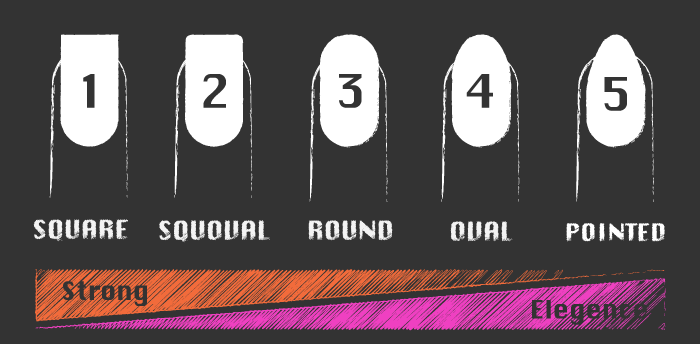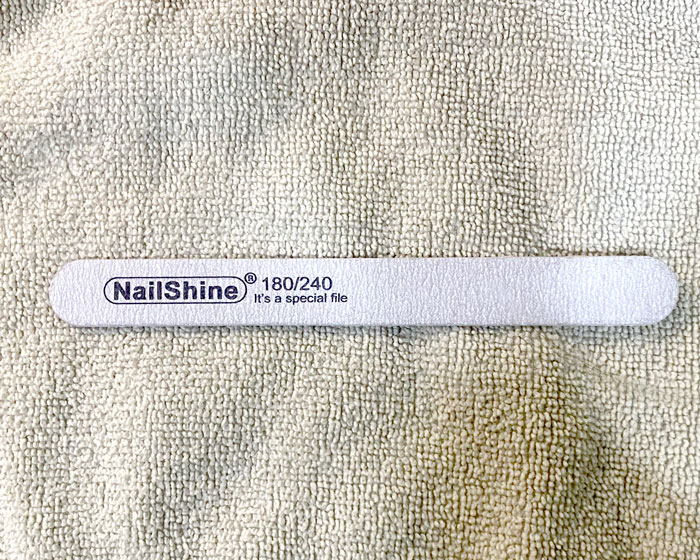Mastering Nail Filing Techniques: Professional Tips for Perfect Nail Shaping

Learn the art of precise nail filing with our professional tips and techniques, ensuring flawless nail shaping for your clients every time.
Introduction to a Variety of Nail Shapes
I’d like to introduce 5 basic nail shapes and other dramatical nail shapes.
5 Basic Nail Shapes for Practical Everyday Use.

- Square: Square-shaped nails feature straight edges and sharp corners, offering a strong, classic appearance. They are well-suited for those seeking a clean and polished look that is durable and practical for everyday activities.
- Squoval: The squoval shape blends the straight edges of square nails with the soft curves of oval nails, striking a balance between durability and a natural, flattering aesthetic. It provides a versatile option for those who want the best of both worlds.
- Round: Round nails have curved edges without any sharp angles, making them easy to maintain and ideal for those who prefer shorter nail lengths. They offer a simple and classic look suitable for various occasions.
- Oval: Oval-shaped nails are characterized by their gentle rounded edges and tapered points, creating the illusion of longer and more slender fingers. They provide a natural and timeless appearance that complements most hand shapes.
- Pointed: Pointed nails, also known as stiletto nails, feature sharp, elongated tips resembling the shape of a stiletto dagger. They offer a bold and dramatic look that is well-suited for those who prefer high-fashion and statement-making nail styles.
Square is the strongest of shapes, while the pointed shape looks your fingers elegance but nails get weaker than other shapes.
For instance, squoval and round shapes are suitable for individuals who frequently use a keyboard. On the other hand, oval and pointed shapes are more suitable for those with thicker or shorter fingers.
Basically, I recommend the round shape.It looks a little more elegant and has more strength.
Exceptions: Other Dramatical Nail Shapes
- The almond shape is characterized by softly rounded sides that taper to a delicate, pointed tip, resembling the shape of an almond. It exudes a graceful and feminine appearance, distinct from the more pronounced, sharper point of a pointed shape.
- Stiletto: This dramatic, high-fashion nail shape features sharp, pointed tips that resemble stiletto heels. It demands longer lengths and requires regular maintenance due to its delicate structure.

- Coffin/Ballerina: Coffin or ballerina nails are characterized by a tapered square tip, resembling the shape of a coffin or a ballerina's pointe shoe. They offer a modern and edgy appearance, combining the strength of square nails with the elegance of an oval shape.
What Tools are Needed for Nail Shaping?
- Nail file: 200 - 240 grits of a file is better for natural nails. When using a new file, shave the edge of its file.

- Sponge buffer: A 220-280 grit sponge buffer is a must. After filing the nails, the sponge file is useful for smoothing the tone of the free edges and removing any nail shavings that remain.
- Nail clippers: If nails need to be cut a lot, cut the free edges before filing.
Basically the file is only required.
Filing the Natural Nails.
There are 3 steps to shaping nail edges.
- Adjust the length of free edges.
- File side nail edges along side walls to prevent cracking from the stress points.
- Shape the nails to your preference.
1. Adjust the Length of Free Edges.
It takes time to file long nails. If the free edges are too long, trim the lengths using nail clippers before filing.Basically I don’t use nail clippers.
The correct way to use nail clippers is to cut a little at a time, 2 to 3 mm from each end of the free edge. If you cut a lot of the free edge together, you will cause damage as if a 10 year old girl stepped on the base of your nail.
Make sure to cut 0.5 - 1 mm longer than the length you want to trim.
Protect the customer's hyponychium and skin with the index finger of your other hand, and support his/her base of the nail with your thumb.
Hold a third of the file with the thumb, index and middle fingers of your dominant hand. Leave other fingers free.
File at a right angle to the free edge. To avoid breaking the nail plate tissue, do not move the file back and forth. Incorrect filing can also cause split nails.
2. File Side Nail Edges along Side Walls.
This process has 2 important keys.
- Prevent hangnail growth on the nail plate.
- Prevent cracking the nail from the stress point.
If it's bleeding or swollen due to the hangnails, do not file.
Pull the side walls back and protect its skin. Place the file parallel to the finger and at a right angle when viewed from above, paying attention not to file to the surface of the inside nail plate. Gently pull the file forward once or twice. After that, confirm the stress point while pulling the side walls as much as possible.
Change the angle of the file to around 180 degrees, almost parallel to the floor, and file straight down the edge of the side nail if there is no problem.
File any small cracks until they are gone. Be careful not to file down to the nail bed under the nail plate.
3. Shape the Nails to your Preference.
Finally, shape nails to your preference. There are 3 tips to shape the nail. Do not file back and forth. Move the file little by little. Check the free edge while touching with the ball of your finger.
After shaping, check that the shape is symmetrical.
Once all nails are filed, check the shape and length of the nails, imagining that all nails will look the same length and shape after color is applied.
Buff the Edges to Remove Any Nail Shavings.
If there are any nail shavings, which look like white skin on the backside of the free edge remaining on the nail edges, remove them with the sponge buffer.
These shavings are made up of the bottom nail layer, which is still connected to the free edge.These can be removed with a cotton stick and alcohol but buffing is easier and nail edges get smoothies.
It's fine to move the sponge buffer back and forth. Place the file at 90 - 45 degrees to the free edge.
If the nails are somewhat long, lightly apply the narrow part of the buffer to the underside of the nail tip to scrape out debris.
- nail
- nail care.